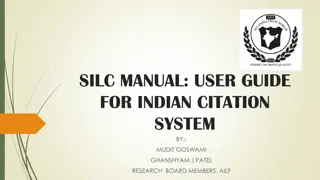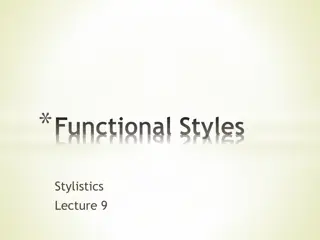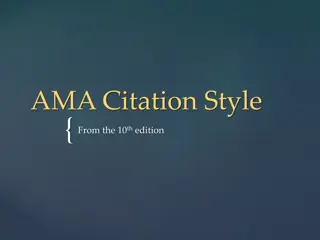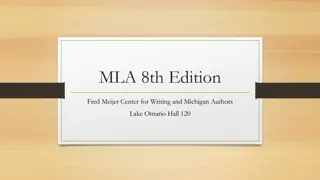Importance of Understanding Citation Styles in Academic Writing
Understanding different citation styles is crucial for academic writing across various disciplines. It helps students comprehend the role of citation in different communities, research methodology, and the value of knowledge in diverse fields. Citation practices in the humanities emphasize authority and individual ideas, shaping scholarly communication. Properly crediting authors and adhering to specific formatting guidelines, such as MLA and Chicago styles, are essential aspects of scholarly writing.
Download Presentation

Please find below an Image/Link to download the presentation.
The content on the website is provided AS IS for your information and personal use only. It may not be sold, licensed, or shared on other websites without obtaining consent from the author.If you encounter any issues during the download, it is possible that the publisher has removed the file from their server.
You are allowed to download the files provided on this website for personal or commercial use, subject to the condition that they are used lawfully. All files are the property of their respective owners.
The content on the website is provided AS IS for your information and personal use only. It may not be sold, licensed, or shared on other websites without obtaining consent from the author.
E N D
Presentation Transcript
Understanding Citation Styles Presented by Melissa Bone and Matthew Nunes English 602
Understanding various citation styles is important for several reasons. Writing across the curriculum Understanding the role of citation in various disciplines and discourse communities Encouraging students to believe that MLA style and citation conventions of the humanities are appropriate for all topics, whatever the discipline, is intellectually chauvinistic ( Dowdey 346).
Understanding various citation styles, continued Understanding the method of research and traditions in scholarship Understanding what knowledge is valued in various disciplines
Understanding various citation styles, continued Dowdey cites Patricia Bizzell, who argues that to help poor writers [ ] we need to explain that their writing takes place within a community, and to explain what the community s conventions are (230) (331).
Citations in the Humanities emphasize authority and individuals ideas and words, privileging the text. Authors depend on shared background knowledge when citing other scholars Relevant passages are cited; long quotations are frequent Knowledge is seen as an accumulation of perspectives 74 % of scholarly journals use a standard style sheet, such as MLA or Chicago
The authors exact words are used Sample in-text citations: Human beings have been described by Kenneth Burke as "symbol-using animals" (3). Human beings have been described as "symbol-using animals" (Burke 3). The author is always given credit Title of article in quotation marks Sample works cited entries: Bagchi, Alaknanda. "Conflicting Nationalisms: The Voice of the Subaltern in Mahasweta Devi's Bashai Tudu." Tulsa Studies in Women's Literature 15.1 (1996): 41-50. Print. names given Authors full Journal titles not abbreviated Gillespie, Paula, and Neal Lerner. The Allyn and Bacon Guide to Peer Tutoring. Boston: Allyn, 2000. Print. Place of publication usually named by city only Only first name of publishing firm given Date comes at the end of the citation
Citations in the Social Sciences are used as an appeal to authority, a starting point for research, and a demonstration of accepted givens. Citations are mostly clustered in the introduction and conclusion Direct quotation is much more infrequent than in the Humanities; ideas rather than words are privileged Proof is provided by surveys, statistical interpretation, and experimental data Only 32 % of journals use a standardized style sheet like APA; most journals have an individualized style sheet
Parenthetical documentation by author and date Sample in-text citations: According to Jones (1998), APA style is a difficult citation format for first-time learners. APA style is a difficult citation format for first-time learners (Jones, 1998, p. 199). Sample reference list entries: Article titles not in quotation marks Full journal titles given Only initials of authors given Berndt, T. J. (2002). Friendship quality and social development. Current Directions in Psychological Science, 11, 7-10. Calfee, R. C., & Valencia, R. R. (1991). APA guide to preparing manuscripts for journal publication. Washington, DC: American Psychological Association. Titles not capitalized Date given prominent position
Citations in the Sciences are used to establish fact and privilege ideas only. Citations are clustered at the beginning of articles, in introductory sections, or in reviews of literature, and often list multiple references. Each citation tends to list multiple references, blurring distinctions between texts Citations are for whole texts rather than passages; when direct quotations appear, the citation comes beforehand The language of the original author is not at all important proof in science scholarship is almost always shown through quantified data Documentation styles vary greatly, even within a specific discipline
Numerical systems; minimal information Sample in-text citations: Oscillation in the reaction of benzaldehyde with oxygen was reported previously. Oscillation in the reaction of benzaldehyde with oxygen was reported previously (3). Sample reference list entries: Black DW: Laughter. JAMA 1984;252:2995-2998. Author names in abbreviated forms Article title not always given; journal titles abbreviated Smith, A., and Jones, C. (1971) J. Biol. Chem. 246, 127-131
Teaching students to understand the role and importance of citation styles is essential in teaching them how to use citation styles. Instructors should supplement these activities on the differences in various citation styles with activities and lessons on actually using these citation styles.
Works Cited Dowdey, Diane. Citation and Documentation Across the Curriculum. Constructing Rhetorical Education. Ed. Marie Secor and Davida Charney. Carbondale: Southern Illinois UP, 1992. Citation examples from Dowdey s article and the OWL at Purdue website: Purdue OWL. "MLA Formatting and Style Guide." The Purdue OWL. Purdue U Writing Lab, 24 Oct. 2009. Web. 1 Nov. 2009.























